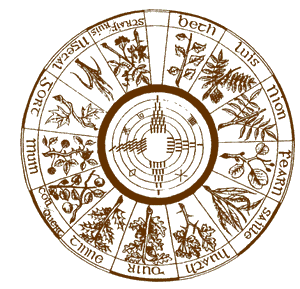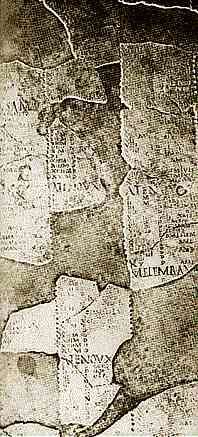 There are three primary schools of thought regarding Celtic calendarical practice (in celtic calendar or a.s. celt calendar). One of the most commonly accepted beliefs holds that the year was divided into thirteen months with an extra day or so the end of the year used to adjust the calendar. This theory states that the months correspond to the vowels of the Ogmah or Celtic tree alphabet. Robert Graves is the major proponent of this school. The evidence he gives is more poetic than archaeological. His interpretation of an ancient poem, The Song of Amergin, appears to be the basis for this calendar.
There are three primary schools of thought regarding Celtic calendarical practice (in celtic calendar or a.s. celt calendar). One of the most commonly accepted beliefs holds that the year was divided into thirteen months with an extra day or so the end of the year used to adjust the calendar. This theory states that the months correspond to the vowels of the Ogmah or Celtic tree alphabet. Robert Graves is the major proponent of this school. The evidence he gives is more poetic than archaeological. His interpretation of an ancient poem, The Song of Amergin, appears to be the basis for this calendar.
Dec. 24 Jan. 21 I am a stag of seven tines Beith the Birch
Jan. 22 Feb. 18 I am a wide flood on a plain Luis the Rowan
Feb. 19 Mar. 18 I am a wind on the deep waters Nuinn the Ash
Mar. 19 Apr. 15 I am a shining tear of the sun Fearn the Alder
Apr. 16 May 13 I am a hawk on a cliff Saille the Willow
May 14 Jun. 10 I am a fair amongst flowers Huath the Hawthorn
Jun. 11 Jul. 8 I am a god who sets the head afire with smoke Duir the Oak
Jul. 9 Aug. 5 I am a battle-waging spear Teinn the Holly
Aug. 6 Sep. 2 I am a salmon in a pool Coll the Hazel
Sep. 3 Sep. 30 I am a hill of poetry Muinn the Vine
Oct. 1 Oct. 28 I am a ruthless boar Gort the Ivy
Oct. 29 Nov. 25 I am a threatening noise from the sea Ngetal the Reed
Nov. 26 Dec. 22 I am a wave of the sea Ruis the Elder
Dec. 23 Who but I knows the secret of the unhewn dolmen?
Most archaeologist and historians accept another calendar. This ca lender is represented by the surviving fragments of a great bronze plate, the Coligny Calendar, which originally measured 5 feet by 3-1/2 feet. This plate, found in eastern France, was engraved in the Gaulish language (similar to Welsh) in Roman-style letters and numerals. It depicts a system of time keeping by lunar months, showing 62 consecutive months with 2 extra months inserted to match the solar timetable. They appear to have worked with a 19-year time cycle that equaled 235 lunar months and had an error of only half a day.
The third school of thought is an amalgam of both of the others. The proponents of this last theory believe that the first calendar pre-dates the Coligny discovery. They lend credence to Mr. Graves interpretation of the poem The Song of Amergin and believe that the Roman influence caused the celts to modify and record their system as represented on the Coligny Calendar. Of course they could just be polite archaeologists.

From Caesar we know the Celts counted by nights and not days and in reckoning birthdays and new moon and new year their unit of reckoning is the night followed by the day. This concept survives in the English term “fortnight,” meaning fourteen nights, or two weeks. Pliny ascribes this form of time measuring specifically to the Druids, “… for it is by the moon that they measure their months and years and also their ages (saeculi) of thirty years.” Ancient Celtic philosophy believed that existence arose from the interplay between darkness and light, night and day, cold and warmth, death and life, and that the passage of years was the alternation of dark periods (winter, beginning November 1) and light periods (summer, starting May 1). The Druidic view was that the earth was in darkness at its beginning, that night preceded day and winter preceded summer a view in striking accord with the story of creation in Genesis and even with the Big Bang theory. Thus, Nov. 1 was New Year s Day for the Celts, their year being divided into four major cycles. The onset of each cycle was observed with suitable rituals that included feasting and sacrifice. According to several sources the Celtic year had eight primary festivals four coincided with the celestial divisions dictated by the movement of the earth the other four, detailed below, had special religious significance. Several celebrations of a more local nature were scattered between each of the major celebrations. The lesser holidays primarily commemorated battle victories or honored local heroes. Some survive as saint s days or other traditional celebrations. Below is a list of the major festivals and their dates on the roman calendar:
Major Festivals of the Celtic CalendarSamhuinn or Samhain 1 November
Samhain (pronounced sow-en) meaning “Summer s End,” is celebrated on Oct. 31 and Nov. 1. A solemn occasion. As darkness overwhelmed the world, the days grew short, and the earth became barren and cold and the veil between the mortal and the supernatural was temporarily drawn aside. Samhain is the beginning of the Celtic new year. This is the time when the rising of Pleiades, heralds the triumph of night over day. Now it is the time of the little sun and the portion of the year which is ruled by the realms of the moon.
In the three days preceding the Samhain, the God of Light Lugh, dies at the hand of his Tanist, who is himself as the Lord of mis-rule. Lugh then passes through the veil between the worlds on Samhain. The Tanist is a stingy and harsh King who while shining brightly in the skies gives no warmth to the land. He cannot warm the north wind which is the breath of the Crone, Cailleach Bheare. This is indicative of the cyclic harmony of seasonal dominance which teaches us that neither Life nor Death can ever hold permanent sway.
Death was never far from our ancestors, and there was not the fear of it that permeates the society we live in. Yet while death itself wasn t feared, it was held important to die with honor. Through dying well, people had the promise of living on in this world through their clan and at Fleadh nan Mairbh (Feast of the Dead). It is at this time the ancestors were honored and the dead were remembered.